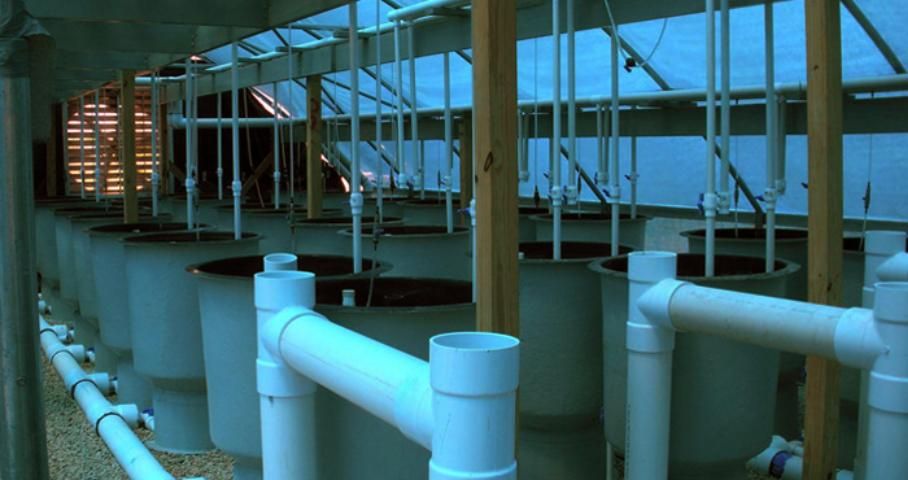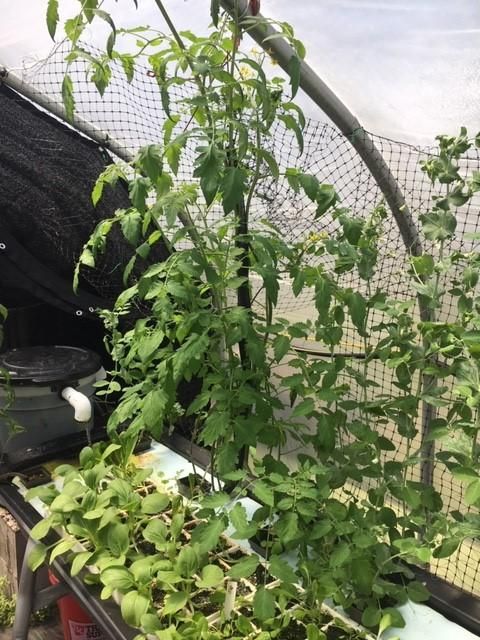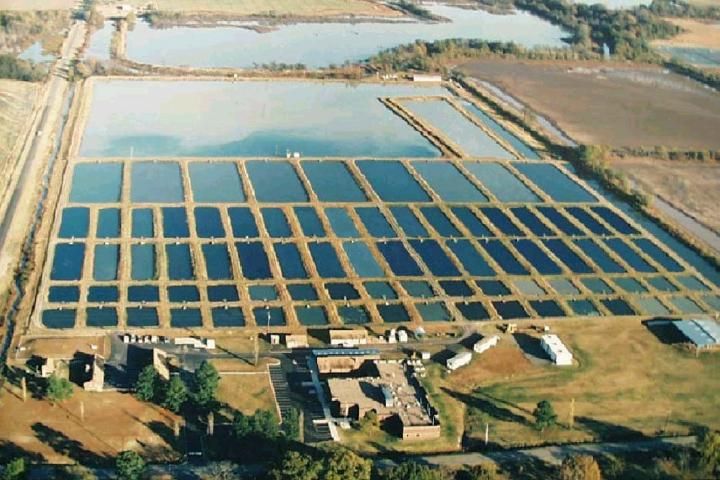Introduction
Population growth and urbanization in Florida and elsewhere is correlated with changes in land use and the reduction of rural acreage (Web 2004). The goal of urban agriculture is to incorporate agricultural production into existing urban systems (RUAF 2018). Areas with large multicultural consumers, diverse labor and investment pools, and well-established distribution infrastructure are good candidates for urban aquaculture (Schreibman 2005).
Unlike traditional aquaculture, urban aquaculture takes place in areas with a greater population density, areas that lack the cheap ecological and space resources found in rural areas.
In this publication, "urban" refers to both inner city and suburban areas and can include backyards, garages, greenhouses, repurposed spaces, rooftops, community gardens, and other non-conventional spaces. Urban aquaculture can shorten the path between farm and plate, generate income, use less resources, and, in some cases, serve as a tool in community building (RUAF 2018). The 2010 US Census identified 3,573 urban areas nationwide, which are defined as densely developed tracts with a population of at least 2,500 people (US Census Bureau 2018). No specific population per square mile is provided with this definition. Urban aquaculture can reduce costs and emissions associated with transportation by producing food closer to where it is consumed, generate income and in some cases, serve as a tool in community building (RUAF 2018).
The objective of this publication is to provide introductory information and links to additional resources for people interested in engaging in commercial or hobby-scale aquaculture in urban or suburban areas. The section on "getting started" details the importance of reliable water and power sources. Three common types of urban aquaculture systems—recirculating, aquaponics, and ponds—are introduced. Lastly, potential resources and unique challenges of urban aquaculture are discussed.
Getting Started
Water
A good source of water is the foundation for any aquaculture operation. The water source should be consistent, reliable, and as close to the desired parameters as possible (Tyson and Simmone 2014). Traditionally aquaculture operations rely on reservoirs, rivers, or groundwater. These water sources may be available in urban environments, but additionally municipal drinking water may be an affordable and reliable water source (Timmons and Ebeling 2013).
Regardless of the water source, it must be lab tested and treated as necessary to ensure that conditions are suitable for aquaculture (Tyson and Simmone 2014). Before using municipal drinking water, it is especially important to remove chlorine and chloramines either chemically with compounds such as sodium thiosulfate, or mechanically via aeration or filtration (Timmons and Ebeling 2013).
RAS and aquaponics generate some amount of water discharge. In highly urban environments it may be necessary to use city waste water systems in accordance with local law. Any discharge into a body of water over 30 continuous days from a facility that produces more than 100,000 lbs of live weight will require a National Pollutant Discharge Elimination System (NPDES) permit from the Florida Department of Environmental Protection; otherwise effluent requirements are detailed in Florida's Aquaculture Best Management Practices (FDACS 2016). (See Permitting and Regulations, below.)
Energy
Aquaculture operations require reliable energy for crucial pumps, aerators, and other equipment. While urban farms will have access to the traditional grid infrastructure, it will still be necessary to have access to alternative power sources in the event of an emergency (Timmons and Ebeling 2013). An instance of low oxygen, for example can kill a crop in a matter of minutes, and access to a diesel or natural gas generator to power emergency equipment will be as necessary in a city as it is in a rural area. As with any new or modified facility, power requirements should be verified against existing grid infrastructure to ensure that loads will not be excessive.
Permitting and Regulations
In addition to general business and operational permits (described in Further Reading, below), all commercial aquaculturists in Florida need an Aquaculture Certificate of Registration, which is administered by the Florida Department of Agriculture and Consumer Services (FDACS).
Holders of an Aquaculture Certificate of Registration must comply with the FDACS Aquaculture Best Management Practices and recertify annually. The Aquaculture Certificate of Registration allows the operation to be legally recognized as an agricultural operation and allows the holder to transport, deal, and possess aquacultured products without additional licensure from the Florida Fish and Wildlife Conservation Commission (FWC).
Operations that wish to raise certain conditional species (examples include certain tilapia and crayfish species, as well as barramundi and arapaima) must apply for additional Restricted Species Authorization from the FDACS and, in some cases, adhere to species-specific requirements.
Facilities that import non-native fish or sell fish that are not cultured onsite must apply for dealer permits from the FWC. Integrated systems such as aquaponics that produce plant products must follow additional regulations and permitting procedures for produce production and sales.
An Aquaculture Certificate of Registration is not required when native species are produced but not sold.
Recirculating Aquaculture Systems (RAS) and aquaponics (see Types of Urban Aquaculture Systems for details on RAS and aquaponics) generate some amount of water discharge. In fully urbanized environments it may be necessary to use city wastewater systems, in accordance with local law, rather than discharge into natural areas. Any facility producing more than 100,000 pounds of aquatic animals annually and discharging into a water body for at least 30 days per year requires a National Pollutant Discharge Elimination System (NPDES) permit from the Florida Department of Environmental Protection; effluent requirements are detailed in Florida's Aquaculture Best Management Practices (FDACS 2016). (See Permitting and Regulations, below)
Types of Urban Aquaculture Systems
Recirculating Aquaculture Systems
Recirculating Aquaculture Systems (RAS) are frequently employed for high-density aquaculture in compact indoor spaces. In RAS, producers use a system of mechanical, chemical, and biological filters to reuse and recirculate the majority of the water in a culture system. Systems have been demonstrated to use up to 90–99% less water than conventional culture techniques such as flow-through raceways or ponds (Timmons and Ebeling 2013). There are numerous types of mechanical filtration and chemical treatment systems to remove waste and treat water. Filter system design and chemical treatment plans will depend on multiple factors such as volume of water, engineering schemes, water quality, or culture intensity (Timmons and Ebeling 2013). Biological filters are used to provide the necessary environment for nitrifying bacteria, which convert toxic ammonia and nitrite waste into relatively benign nitrate (Timmons and Ebeling 2013).
RAS are well suited to urban environments because, with careful design consideration, they can be space efficient and reduce water usage. RAS can be used indoors, which can be beneficial for revitalizing unused urban spaces (Timmons 2005). Concentrated waste from RAS can be integrated into terrestrial agriculture (such as an urban garden) or hydroponics. (See the Aquaponics section of this fact sheet below.) These systems can be quite costly to build and will require more expertise and skilled labor than traditional aquaculture. Additionally, due to the intensive nature of RAS, water quality and disease management can be challenging and time consuming (Yanong 2010).

Credit: Courtney Ohs, UF/IFAS
Aquaponics
Aquaponics is a name given to the integration of hydroponics (growing plants without soil) with recirculating aquaculture. Aquaponics combines the nitrate-rich wastewater from intensive RAS with popular hydroponics techniques such as floating rafts, nutrient films, or bench bed systems (Tyson and Simmone 2014). Systems can be designed to produce a variety of plant and aquaculture products. In this integrated system, producers must balance the needs of the plants with the needs of the fish and the needs of the biological community (Tyson et al 2018). Therefore, harmonizing species selection and system design is crucial with regards to temperature and the chemical composition of the water. Optimal plant growth generally requires additional inputs such as iron, potassium, and calcium, which may not be provided by fish waste alone (Somerville et al 2014). Aquaponic systems can be housed in greenhouses or indoors with artificial lighting. Facilities with limited commercial production success have successfully incorporated agritourism and agricultural education into their operations. (Love et al 2015).

Credit: Laura Tiu, UF/IFAS Florida Sea Grant College Program
Pond Aquaculture
Pond aquaculture is traditionally a land-intensive practice. However urban sprawl is contributing to agricultural land being reclassified to transitional land, which is defined as suburban land that is likely to be converted to non-agricultural uses (Web 2004). As populations continue to increase, operators of traditional pond systems may face challenges from land-use and zoning changes. These same changes may also increase the value of land historically used for pond aquaculture to a point where commercial or residential development is more economically appealing than continued agricultural use. Thus, large-scale pond aquaculture is unlikely to be an option in most urban and even suburban areas.

Credit: USDA
Resources and Challenges
Capital and Marketing
The UF/IFAS Small Farms and Alternative Enterprises Program provides educational resources and agrobusiness tools to start-up farmers, including tools to aid in farm financing, business planning, and financial management. Other small farms programs nationwide have additional resources for financial planning and finance, such as Cornell University's Small Farms Program or the University of California-Davis Small Farm Program.
Using these tools, emerging aquaculturists can gather the information necessary to apply for farm or small business loans. The US Farm Credit Administration publishes a list of banks that are required to have programs that serve new farmers and start-up or small farms.
Small and alternative enterprises also can qualify for grants and micro-loans. Grants and micro-loans may be available from governments or non-profits. The FDACS, the US Department of Agriculture (USDA), and the National Center for Appropriate Technology (NCAT) post regularly updated lists of alternative funding opportunities on their respective websites. (See Resources, below.)
Size limitations of urban aquaculture operations will limit the ability to compete with traditionally produced aquaculture products, which rely on an economy of scale (Swisher 2016). Smaller enterprises that aim to garner commercial profit are encouraged to rely on direct marketing techniques such as selling at farmers' markets and selling directly to restaurants and food cooperatives (Swisher 2016).
Unique Challenges for Urban Aquaculture
Zoning and land-use law will vary greatly by the county, city, and even neighborhood or subdivision levels. Interested parties are encouraged to contact local resources such as 311 or local government offices, their county UF/IFAS Extension office, the Florida Aquaculture Association, and the Florida Farm Bureau for more information regarding local agricultural and land-use law. Proximity to other industries carries the increased risk of contamination. Sources could include traffic fumes or urban runoff (Bunting et al 2006).
Starting an agriculture operation in an urban environment, even when properly zoned and when following Best Management Practices, may lead to nuisance complaints (Lapping and Leutwiler 1987). Aquaculture is protected by the Florida Right to Farm Act, which protects agricultural operations that follow Best Management Practices from being deemed a public or private nuisance. However, the act only protects operations that have been in operation for at least a year. Because this statute does not protect new farms, urban start-ups must be especially mindful of neighboring homes and businesses (Lapping and Leutwiler 1987).
Conclusion
Urban aquaculture can be a challenging but rewarding endeavor. In addition to providing locally produced goods and contributing to urban economic growth, urban aquaculture can foster an appreciation of ecology and natural systems in urban communities (Buttner 2005).
Those who are interested in learning more are encouraged to reach out to their county UF/IFAS Extension Office, the UF/IFAS Small Farms and Alternative Enterprises Program, and other groups such as the Florida Aquaculture Association.
Further Reading
A Practical Guide for Aquaponics as an Alternative Enterprise: https://edis.ifas.ufl.edu/hs1252
Recirculating Aquaculture Tank Production Systems A Review of Current Design Practice: http://fisheries.tamu.edu/files/2013/09/SRAC-Publication-No.-453-Recirculating-Aquaculture-Tank-Production-Systems-A-Review-of-Current-Design-Practice.pdf
Recirculating Aquaculture Tank Production Systems Aquaponics- Integrating Fish and Plant Culture: http://fisheries.tamu.edu/files/2013/09/SRAC-Publication-No.-454-Recirculating-Aquaculture-Tank-Production-Systems-Aquaponics-Integrating-Fish-and-Plant-Culture.pdf
An Overview of Small Farm Direct Marketing: https://edis.ifas.ufl.edu/fy597
How to Start a Food Business Introduction: https://edis.ifas.ufl.edu/fs254
How to Establish an Urban Agriculture Ordinance: https://edis.ifas.ufl.edu/hs1327
Resources
ATTRA National Sustainable Agriculture Information Service Funding: attra.ncat.org/funding/
Cornell University Small Farms Program: https://smallfarms.cornell.edu/
Farm Credit Administration: www.fca.gov
Florida Aquaculture Association: www.flaa.org/
Florida Department of Agriculture and Consumer Services Grant Opportunities. https://www.fdacs.gov/Business-Services/Grant-Opportunities
Florida Department of State Division of Library and Information Services "Starting a Business in Florida": https://dos.myflorida.com/library-archives/research/florida-information/business/starting-a-business-in-florida/
Florida Farm Bureau: https://www.floridafarmbureau.org/
Southern Regional Aquaculture Center Fact Sheets: https://srac.msstate.edu/FactSheets.html
United States Department of Agriculture Grants and Loans: www.usda.gov/topics/farming/grants-and-loans
United States Department of Agriculture Urban Agriculture Resources: www.nal.usda.gov/afsic/urban-agriculture
The University of California Small Farms Research and Extension: https://sfp.ucanr.edu/
The University of Florida IFAS Extension Small Farms and Alternative Enterprises: smallfarm.ifas.ufl.edu/beginning-farmer/
Sources
Bunting, Stuart, et al. 2006. Urban Aquatic Production. RUAF Foundation. https://ruaf.org/assets/2019/11/Cities-Farming-for-the-Future_compressed.pdf#page=382.
Buttner, Joseph K. 2005. "Urban Aquaculture: A Necessary Reality." Urban Aquaculture. CABI Publishing.
FDACS, Aquaculture Division. 2016. Aquaculture Best Practices Manual. Florida Department of Agriculture and Consumer Services. https://www.freshfromflorida.com/content/download/64045/1520653/BMP_Rule_and_Manual_FINAL.pdf
FDACS, Aquaculture Division. 2018. Aquaculture Certificate of Registration. Florida Department of Agriculture and Consumer Services. https://www.fdacs.gov/Agriculture-Industry/Aquaculture/Aquaculture-Certificate-of-Registration
Florida Statute. 2018. "Florida Right to Farm Act." Online Sunshine www.leg.state.fl.us/Statutes/index.cfm?App_mode=Display_Statute&URL=0800-0899/0823/Sections/0823.14.html
FWC. 2018. Aquaculture Certificate. Florida Fish and Wildlife Conservation Commission, myfwc.com/license/commercial/aquaculture/. (December 2018).
FWC. 2018. Aquaponics Licenses and Permits. Florida Fish and Wildlife Conservation Commission, myfwc.com/license/commercial/aquaponics/. (December 2018).
Lapping, M. B., and N. R. Leutwiler. 1987. "Agriculture in conflict: right-to-farm laws and the peri-urban milieu for farming." Sustaining Agriculture Near Cities. Boston: Soil and Water Conservation Society, pp.209–218.
Lazur, Andy M., et al. 2016. The Use of Lime in Fish Ponds. FA38. Gainesville: University of Florida Institute of Food and Agricultural Sciences. edis.ifas.ufl.edu/fa028.
Love, David et al. 2015. "Commercial aquaponics and profitability: Findings from an international survey." Aquaculture. 435:67–74. https://doi.org/10.1016/j.aquaculture.2014.09.023
Ohs, Cortney. 2010. "University of Florida Indian River Research and Education Center Aquaculture Research and Demonstration Facility Fort Pierce, FL." University of Florida Institute of Food and Agricultural Sciences. https://irrec.ifas.ufl.edu/aquaculture/
The RUAF Foundation. 2018. Urban Agriculture: What and Why?. www.ruaf.org/urban-agriculture-what-and-why. (September 2018).
Schreibman, Martin P. 2005. "Urban Aquaculture in Brooklyn, New York, USA." Urban Aquaculture. CABI Publishing.
Somerville, Christopher et al. 2014. "Small-Scale Aquaponic Food Production." FAO Fisheries and Aquaculture Technical Paper 589. Food and Agricultural Organization of the United Nations. http://www.fao.org/3/a-i4021e.pdf
Swisher, M. E. 2016. An Overview of Small Farm Direct Marketing. FCS7211. Gainesville: University of Florida Institute of Food and Agricultural Sciences. edis.ifas.ufl.edu/fy597
Timmons, Michael B. 2005. "Competitive Potential for USA Urban Aquaculture." https://edis-admin.ifas.ufl.edu/publications/FA217/3232111/
Timmons, Michael B., and James M. Ebeling. 2013. Recirculating Aquaculture. Ithaca Publishing Company.
Tiu, Laura. 2018. "Aquaponics: Growing Fish and Food." blogs.ifas.ufl.edu University of Florida Institute of Food and Agricultural Sciences. http://blogs.ifas.ufl.edu/okaloosaco/2018/03/14/aquaponics-growing-fish-food/
Tyson, Richard, and Eric Simmone. 2014. A Practical Guide for Aquaponics as an Alternative Enterprise. HS1252. Gainesville: University of Florida Institute of Food and Agricultural Sciences. https://edis.ifas.ufl.edu/hs1252
Tyson, Richard V, et al. 2018. "Opportunities and Challenges to Sustainability to Aquaponic Systems.". HortTechnology. horttech.ashspublications.org/content/21/1/6.full.pdf html
Webb, James E. 2004. "The Economic Impact of Urbanization on the Florida Vegetable Industry." Plaza.ufl.edu. University of Florida Institute of Food and Agricultural Sciences. plaza.ufl.edu/jewebb/strawberrypaper.pdf
Yanong, Roy. 2010. Fish Health Management Considerations in Recirculating Aquaculture Systems—Part 1: Introduction and General Principles. FA099. Gainesville: University of Florida Institute of Food and Agricultural Sciences. https://edis.ifas.ufl.edu/fa099